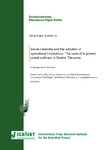| dc.description.abstract | Literature on the adoption of agricultural innovations highlights the importance exposure to
these technologies for the adoption decision of small scale farmers. This study assesses the
relevance of exposure and other constraints in the adoption of improved sorghum and maize
cultivars in Central Tanzania. Specifically, we analyze the determinants of exposure to
improved varieties; and of adoption itself, focusing more on the role of social networks. We
use survey data collected from 345 farmers between September and November 2012. We
apply Poisson models to assess exposure, and average treatment effect procedures to
analyze adoption. Our results show that about 79% and 74% of the respondents are
exposed to at least one improved variety of sorghum and maize respectively. The average
intensity of exposure (number of improved cultivars a farmer is exposed to) was 1.7 for
sorghum and 1.8 for maize. Farmer networks are found to be a key source of variety
information, and exchange of this information among farmers is triggered when a farmer
sights a variety grown in a network member’s field. Most farmers consider improved varieties
of both crops generally better than traditional ones. However, while 83% of farmers think
improved varieties of maize are better than traditional ones, only 54% of farmers think so for
sorghum. The size of a farmer’s network is found to positively influence their intensity of
exposure to improved sorghum and open-pollinated maize varieties, but not to maize
hybrids. This demonstrates that farmer networks facilitate higher exposure to seed
technologies with mostly missing or malfunctioning markets. We find that farmers have
substantial information networks outside their own villages, and it is these often understudied
networks that determine the intensity of exposure. The strength of network connections with
village administrators positively affects intensity of exposure to sorghum varieties, while
network connections with agricultural extension officers influence intensity of exposure
positively for sorghum varieties and maize hybrids. Other determinants of exposure are age
and education of household head, and household ownership of information and
communication assets. Female farmers have less exposure to maize hybrids than their male
counterparts. On adoption, we find that adoption rates are pretty low – just about 42% in the
case of sorghum and 60% for maize. After accounting for non-exposure and selection
biases, the estimated population adoption rate is 52% for sorghum and 71% for maize,
implying adoption gaps of 9.3 and 10.9 percentage points, respectively. Sorghum networks
positively influence adoption even after accounting for their role in exposure. However, it is
the intra-village and not inter-village networks that produce this effect. Intensity of exposure
influences adoption positively for both crops. Households with more female adults are more
likely to adopt improved sorghum, while those with more male adults are more likely to adopt
improved maize. Poor soil fertility negatively affects adoption of improved sorghum, while
non-farm income activities and size of maize farm positively influence adoption of maize
varieties. Farmers mentioned seed availability followed by perceived susceptibility to pests
as the most limiting factors to adoption. The importance of these reasons changes if we
compare farmers without past adoption experience to those who have ever adopted. These
results raise a number of implications for policy design and further research, which are
discussed in the last chapter of this paper. | en_US |

